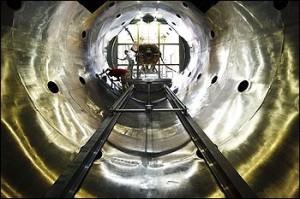Learning’s About to Leap Again
Posted on March 30, 2010
Filed Under Technology | Leave a Comment
This could be one of the most important weekends since Johannes Gutenberg announced the invention of moveable type 570 years ago. And, says Wikipedia, Gutenberg’s breakthrough for learning the world over is “widely regarded (as) the most important event of the modern period.” The printing press greatly abetted, if not launched, the Renaissance, Reformation and the Scientific Revolution which, of course, gave rise to modern times.
Well, Apple Computer’s iPad goes on sale Friday. Don’t scoff when we compare the shiny tablet to Gutenberg’s new printing technology. The more people learn about the iPad, the more excited they seem to become about it. At first as Steve Jobs announced the device in January, Daniel Lyons recalls in the cover story of this week’s Newsweek, “it seemed like no big deal. It’s a bigger version of the iPod Touch, right? Then I got a chance to use an iPad, and it hit me, I want one.”
 A lot of people who haven’t tried an iPad yet seem to feel the same way. One estimate is that 200,000 of them will be sold this weekend. That’s not only significant for Apple, but for literacy in our time. Why? Because ebooks, led possibly by the iPad, are likely to make electronic learning common, and perhaps more successful than paper-based instruction, in classrooms and households around the world. (Amazon bought Newsweek’s back cover to promote its own Kindle ereader, probably in hopes of keeping abreast of Apple.)
A lot of people who haven’t tried an iPad yet seem to feel the same way. One estimate is that 200,000 of them will be sold this weekend. That’s not only significant for Apple, but for literacy in our time. Why? Because ebooks, led possibly by the iPad, are likely to make electronic learning common, and perhaps more successful than paper-based instruction, in classrooms and households around the world. (Amazon bought Newsweek’s back cover to promote its own Kindle ereader, probably in hopes of keeping abreast of Apple.)
You can not only read books but watch movies, play games, listen to music, send email and sort photographs on the battery-powered iPad. And it only needs to be in your lap, not on a desktop. (We haven’t heard yet whether you’ll be able to print from the touch keyboard, but we suspect so. If not now, soon.)
Think what the iPad and other tablet approaches to reading and learning mean. They bring together all the excitement that youngsters have been experiencing growing up with computers and the Internet, all the new windows they have on the world. And it’s fun, exhilarating actually, to open and use them.
What might that do for further learning and creativity? Stick around a while, please do. This new era isn’t to be missed.
“There’s a wholesale transition building steam around the way content is distributed and then accessed by students and teachers, and there are multiple formats, multiple devices and multiple distribution channels,” Rik Kranenburg, president of the higher education, professional, and international group at McGraw-Hill Education says in the April EContent magazine.
“The combination of print and digital offerings does very impressive things,” Kranenburg adds “It opens up new opportunities to make instruction and study more effective, more efficient and more personalized.”
A lot of wood carvers and wielders of ink brushes were probably thinking much the same thing in Johannes Gutenberg’s day. Questions remain about how ebooks will be gotten into the hands of people everywhere, but the first typeset books didn’t circulate widely either.
Incidentally, Seton Hill University in Greensburg, Pa., is providing each of its full-time students with an iPad and a 13″ MacBook laptop – screens in the wind? – Doug Bedell
Bank Closings ‘In Perspective’
Posted on March 26, 2010
Filed Under Business | Leave a Comment
It’s work these days to keep things in perspective but it’s worth the effort. For instance, we’ve just had the 41st bank closing in 2010. Forty-one banks shuttered, and the year isn’t three months old. Sounds like a lot, doesn’t it? Not really, maybe.
When you head over to the Federal Deposit Insurance Corp.’s website, you find that there were “thousands” of bank failures in the 1920s and early 1930s, which, as we know, led to the formation of the FDIC itself.
Now when a bank closes, depositors are insured up to $250,000 per account so nobody looses any money, unless they foolishly kept more than a quarter million in a given account.
The four banks that were just closed will cost the FDIC insurance fund around $320.3 million and $100 billion is expected to be needed to cover failed banks over the next four years. But no matter, the FDIC currently has $66 billion in cash and securities in reserve, and the government is likely good for the rest.
 So get inured to bank closings, they’re nothing to lose sleep over anymore. Neither are continued layoffs by state governments, nor the problems young people are having finding jobs – the recovery is gaining strength, isn’t it?
So get inured to bank closings, they’re nothing to lose sleep over anymore. Neither are continued layoffs by state governments, nor the problems young people are having finding jobs – the recovery is gaining strength, isn’t it?
© iStockphoto/ilbusca
Unsettling times indeed. They call for policies to unleash the creativity and ability available in the American people. We don’t know quite what those policies ought to be, but we were heartened to hear that part of the supplemental health care bill that Congress just passed to “fix” the first one included “education provisions that help students with loan payments.
“The education related initiatives funded by the law are fully paid for by ending the government subsidies currently given to banks and other financial institutions that make guaranteed federal student loans,” the White House said in a statement.
So maybe the banks aren’t getting entirely solicitous treatment after all. Hard to say.
Wherever we’re headed, we certainly feel there’s a role for creative, compassionate government, one that unlocks potential and doesn’t simply hoard whatever it is that anti-government politicians seem to feel needs hoarding.
Do your job Washington, and keep us informed every step of the way. We’re rooting for you. And we’re keeping those bank closings “in perspective.” – Doug Bedell
‘Augmented Reality’ On the Highways
Posted on March 19, 2010
Filed Under Technology, Uncategorized | Leave a Comment
We practically launched Insights with a post about electric cars and our hopes that Chevrolet’s Volt will indeed be launched in November. Now here’s Guy Kawasaki test-driving a Volt at the SXSW new media conference in Austin.
It runs! It handles nicely! Its approximate range will be 400 miles on an eight-gallon tank of gas and the electric motor will always power the car! This last is a reference to the Volt being a “series” hybrid. Existing hybrids are “parallel” vehicles – “the electric motor powers the car for low speeds, and the gasoline engine kicks in for greater acceleration and higher speeds,” Kawasaki advises.
 It’s interesting (though dismaying) to note that the Volt test-driving was done in the parking lot of an Austin shopping mall where most of the stores were out of business – a hapless setting not unlike Detroit itself.
It’s interesting (though dismaying) to note that the Volt test-driving was done in the parking lot of an Austin shopping mall where most of the stores were out of business – a hapless setting not unlike Detroit itself.
With electric cars, though, we may be at the symbolic juncture of two eras in the U.S.: the decline of the old manufacturing economy and the rise of a new innovation-powered one that’s good for renewed production of industrial goods and jobs. We certainly need that kind of good fortune. And we’re wishing the Volt all success (at a reasonable price, of course).
Now, if electrically-powered transmission can be coupled with GM’s new “augmented reality windshield” we may really have something! GM says the new windshield can highlight landmarks, obstacles and road edges before a driver’s eyes, in real time. It can point out to drivers potential hazards, such as a running animal, even in foggy or dark conditions.
Boy, that would be great. Maybe “augmented reality” can even catch sight of a revived, prosperous and reliable industrial economy for us all. Right on at the new GM! – Doug Bedell
A Green Brownfield… Now that’s an Idea Worth Pursuing!
Posted on March 16, 2010
Filed Under Business, Technology | Leave a Comment
Whenever engineers gather—particularly engineers whose hairlines are either receding or tinged with gray—the conversation often turns to the sad state of infrastructure renewal in this country. Those engineers recall the “old days” when either they or their fathers (sorry, very few female engineers in those days) worked on large projects that were actually conceived, approved, and built on budget and on schedule.
The contract for Hoover Dam was awarded in 1931 and the dam was dedicated in 1935, two years ahead of schedule and about $15,000,000 (30%) under budget. Imagine trying to obtain approval today for that project, or for the approximately 47,000 mile Interstate Highway System, a national treasure that accounts for about one-third of all miles Americans drive. Today we are hard-pressed to build a much needed power plant (green or not) or bridge, let alone something of real national significance (such as Yucca Mountain… billions spent for naught).
 Perhaps a new push by the EPA and DOE will help reverse this dreadful record, at least for some of the less controversial infrastructure projects. According to an Energybiz Insider article, those agencies are considering regulations to encourage renewable energy plants (solar, wind, and hydro) on brownfields, that is, contaminated and abandoned industrial sites. Every state has such sites, and they total about 450,000 acres in the U.S.
Perhaps a new push by the EPA and DOE will help reverse this dreadful record, at least for some of the less controversial infrastructure projects. According to an Energybiz Insider article, those agencies are considering regulations to encourage renewable energy plants (solar, wind, and hydro) on brownfields, that is, contaminated and abandoned industrial sites. Every state has such sites, and they total about 450,000 acres in the U.S.
The article cites a few such success stories, including an abandoned steel mill in New York that is now home to a wind farm, and a U.S. Army facility in Colorado where solar electric panels have been installed. One hopes that even the hardcore NIMBYs might prefer a green energy power plant—however modest in output—to an abandoned, chemical-laden brownfield in their communities. Then again, if the chemical soup on the site caused algae to mutate into a deadly new life form I’m sure there would be intervenors carrying “Save the Scum” placards. — Dennis Owen
View Earth’s Climate Prudently
Posted on March 12, 2010
Filed Under Technology | Leave a Comment
The debate over climate change troubles me, especially now that the doubters seem to be gaining. But I don’t hold to the irritating “conclusion” reached by Bill Chameides, Dean of Duke University’s Nicholas School of the Environment and a member of the Natonal Academy of Sciences, who presents some of the latest poll findings on The Huffington Post.
Noting that “America has experienced a cool patch of late,” Chameides writes that “Some scientists have conjectured that it has something to do with the jet stream. But what do they know? I think it could be due to the Tea Party. With all their speechifying, finger-wagging, and chanting, they may have used up all of the nation’s hot air. ”
 That sounds pretty undeanly to me. The problem with climate change is that it’s a long-term trend, not immediately measurable in any conclusive way. And that sort of reassuring evidence seems to be what many of us want.
That sounds pretty undeanly to me. The problem with climate change is that it’s a long-term trend, not immediately measurable in any conclusive way. And that sort of reassuring evidence seems to be what many of us want.
I write as a spring rain washes away the last of a huge pile of snow we’ve had out front for weeks now. We’ve had a rough winter here in Central Pennsylvania. But that, in itself, doesn’t say anything decisive about whether the climate is heating up or cooling down. We’ve got to be patient about scientific things.
More importantly, when a dispute involves the state of the entire planet and its atmosphere we have to err on the side of caution. That is, we should be acting as if the climate is heating up, even if we can’t be completely sure that it is. (Even though most scientists, apparently, would argue about that.) The risks if we do little or nothing and the scientific consensus is correct are just too great. Prudence matters more than emotions.
If we limit emissions of greenhouse gases, we have a cleaner environment, whether or not icebergs keep melting. That’s a plus we should all be willing to share in achieving.
I wrote the other day on another blog that monitoring climate research calls for “the most enlightened public relations project ever.” I suggested that a website like Solveclimate.com might be the answer. I didn’t know then about NOAA’s “State of the Climate” site, though it may not be focused enough.
I appreciate, however, Bill Chameides making me aware of the NOAA site. That’s the best we can do for all of us – make information available, think prudently and take steps to improve the quality of our environment, whatever Earth’s long-term fate may be. – Doug Bedell
NASA Needs New Rockets
Posted on March 9, 2010
Filed Under Technology | Leave a Comment
NASA exists to satisfy a national travel itch – we want to explore space and NASA’s rockets are the means of doing so. The problem is, there are only a few celestial destinations we’ll be able to reach in the next few decades. And NASA needs not so much a map as a method to get to them.
President Obama wants to develop better rocketry before heading off again to the moon, or to somewhere else reachable in space, perhaps an asteroid and, ultimately, Mars. Truly, this is a high technological challenge.
As The Washington Post recently reported, “future space flight, NASA officials say, now depends on new rocket science and where it can take us.”
 So NASA needs not to be wistful, but extra ingenious. Practicality never counted for so much in technological terms. If we’re going to venture further into space, we need better rockets. Our reach into space depends on getting better, ever more ingenious, technically.
So NASA needs not to be wistful, but extra ingenious. Practicality never counted for so much in technological terms. If we’re going to venture further into space, we need better rockets. Our reach into space depends on getting better, ever more ingenious, technically.
Like the original moon program itself, space is challenging our technical genius. We reach new frontiers, now, by having better propulsion systems. If we don’t come up with them, we stay home.
Maybe we should stay home anyway, some will say. But the space program has always been a key means of technical progress, with developments in space exploration being adapted and dispersed for everyday use.
So good luck on those rockets, NASA, and anyone else who can help us explore the universe. We’re getting really itchy again for extraterrestrial travel.
– Doug Bedell
South From Alaska (Sarah’s Song)
Posted on March 2, 2010
Filed Under The Writing Life | 1 Comment
Sarah Palin…what thoughts does that name invoke? Obviously, that depends on your politics. But in a just world her name would invoke much more than an unthinking reaction based on her— and your — place on the political continuum. Politics aside, she should be respected for her quite remarkable accomplishments. Athlete (cross-country and Alaska state championship basketball team), beauty pageant winner, sports reporter (TV and print), city mayor, governor of Alaska (first woman and youngest at 42), candidate for vice president, best-selling author, television commentator, self-made millionaire. If you dismiss that record of accomplishment based on politics, it says much more about you than it does about her.
With these thoughts rolling around in my head, my iPod shuffle offered up Johnny Horton’s North to Alaska. So here, with apologies to Johnny, is:
South from Alaska
Sarah left Wasilla, with important work to do
The first woman and the youngest, state governor at forty-two
She traveled south to Juneau, to try things new and bold
She fought for all Alaskans
And her years up there were gold
Sarah crossed Alaska’s mountains, to St. Paul she was bound
With husband Todd and children, the newest face around
She spoke about her family, and the need to set things right
The hockey mom from Alaska, brought down the house that night
CHORUS
The country is fallin’
The people are callin’
South from Alaska
Go south to lead the charge
South from Alaska
Go south to lead the charge
This country needs a leader, who loves this blessed land
Who with heart and soul believes it is, the last best hope of man
Who will stand proud and proclaim it, over land and air and seas
Our principles are simple, and those principles are these
I am my brother’s keeper, you can leave that up to me
Those who seek to harm us, will soon the eagle see
The wealth of this great nation, must be in the people’s hands
There’s peace on earth before us, if one with God we’ll stand
CHORUS (end)
Well that’s my modest contribution to the Sarah Palin story. It is modest indeed, and there are a number of lines that are weak and just don’t click. Send me your markups (info@EncoreTechResources.com) and we’ll beef up the lyrics together (giving you credit of course), and Insights will publish our much improved version of Sarah’s song.
By the way, as pro-Palin as this posting sounds, I personally don’t think she should run. I see her role as a conservative gadfly, prodding the next Republican administration to hew to its libertarian principles. — Dennis Owen
Recently
- Presentations With Forethought
- Technical Writing’s Lineage – Surely It’s Deeper than Digital
- At the Holidays, Twitting Amazon
- Successful Cookie Baking – From Mom, an Acknowledged Expert
- Slides for a Tech Writer’s Craft
- Digital or Not, Be Clear
- Being Watchful About Digital Designs…
- When Proposals Don’t Click, Keep Making Them Anyway
- Like a Good Gardener, Help an Enterprise Keep Itself Current
- We’re Leaders All, And Need to Think That Way
Categories
Archives
- January 2017
- December 2016
- November 2016
- October 2016
- September 2016
- August 2016
- July 2016
- June 2016
- May 2016
- April 2016
- March 2016
- February 2016
- January 2016
- December 2015
- November 2015
- October 2015
- September 2015
- August 2015
- July 2015
- June 2015
- May 2015
- April 2015
- March 2015
- February 2015
- January 2015
- December 2014
- November 2014
- October 2014
- March 2014
- February 2014
- January 2014
- December 2013
- November 2013
- October 2013
- September 2013
- August 2013
- July 2013
- June 2013
- May 2013
- April 2013
- March 2013
- February 2013
- January 2013
- December 2012
- November 2012
- October 2012
- September 2012
- August 2012
- July 2012
- June 2012
- May 2012
- April 2012
- March 2012
- February 2012
- January 2012
- December 2011
- November 2011
- October 2011
- September 2011
- August 2011
- July 2011
- June 2011
- May 2011
- April 2011
- March 2011
- February 2011
- January 2011
- December 2010
- November 2010
- October 2010
- September 2010
- August 2010
- July 2010
- June 2010
- May 2010
- April 2010
- March 2010
- February 2010
- January 2010